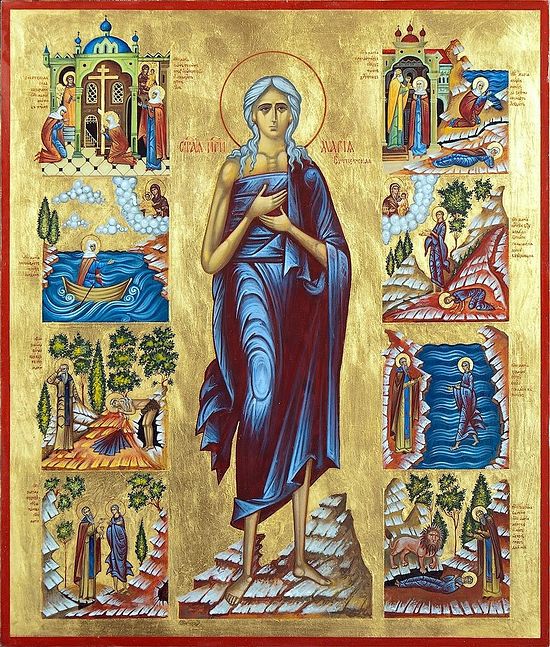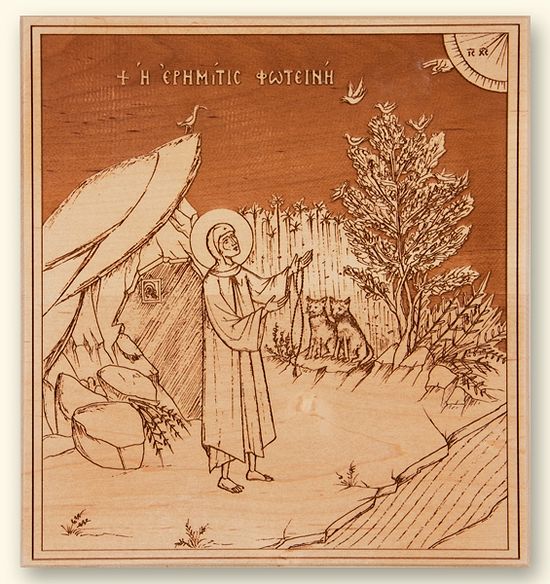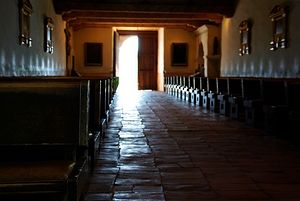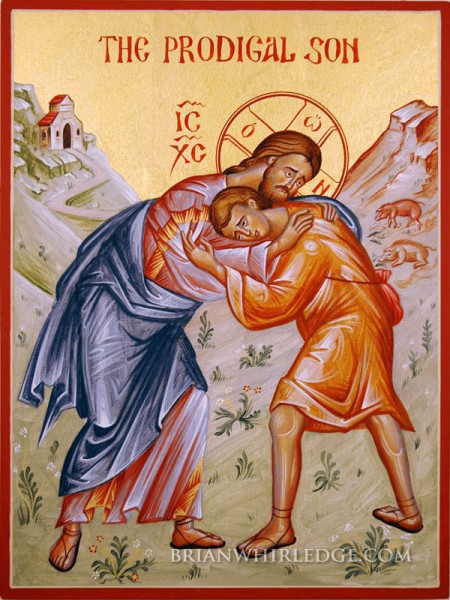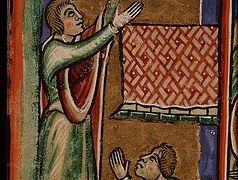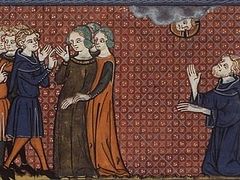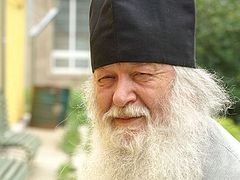To admire the labours of the saints is good;
to emulate them wins salvation;
to wish suddenly to imitate their life in every
point
is unreasonable and impossible.
INTRODUCTION
Today we commemorate St. Mary of Egypt, who is the third saint whom the Church has brought to our attention during this period of Great Lent; the first two being St. Gregory Palamas and St. John Climacus. Last Sunday we commemorated St. John Climacus as the model of ascetics and today we commemorate St. Mary of Egypt, who is for us the model of repentance as we sang in the exapostilarion for the saint last evening, “Thee we have as a pattern of repentance, all-holy Mary.” From her life, let us see how this is so.
The Life of St. Mary of Egypt
The story of her life has been read to us during Vespers this past Wednesday and should still be fresh in our minds, so I will not describe her life in detail but will only summarize it.
After moving away from her parents at the age of twelve, she describes her life as being “like a fire of public debauchery”. At the age of twenty-nine, she was at the Church of the Holy Sepulchre for the feast of the Precious Cross but was prevented from stepping into the nave by what she describes as “an invisible force.” At that moment, Divine grace softened her heart, and she repented and prayed before an icon of the Mother of God promising to fulfill whatever she was told. She was then allowed entry into the nave to venerate the precious wood of the cross. Afterwards, she heard a voice instructing her in what to do. Obeying these instructions, she left the Church, crossed the Jordan River into the desert and lived there from the age of twenty-nine until she was seventy-six at which time she was met by the monk Zosimas and after which she lived two more years.
Upon Zosima’s encounter with the saint in the wilderness and speaking to her, we learn of the kind of saint that St. Mary was. Some people doubt the almost supernatural existence of St. Mary’s life but may we be reminded of those saints who were comparable to her. Her life is very similar to the life of the Hermitess Photini, and is akin in various ways to St. Seraphim of Sarov, St. Ambrose of Optina, St. Silouan of the Holy Mountain, St. John of Shanghai and San Francisco and also many contemporary ascetics of Mount Athos to name only a few. Therefore, may we not, because of the weakness of human nature, “consider impossible these wonderful things accomplished by holy people,” as St. Sophronius encourages us in his introduction to the life of St. Mary. Although it may not always be apparent in our own times, these gifts are “only a normal step in the growth of a monk,” from the first century to our day or, as the model of asceticism from last Sunday writes, “Let no one on seeing or hearing something supernatural in the monastic way of life fall into unbelief out of ignorance; for where the supernatural God dwells, much that is supernatural happens.”
Why do we need to repent? The Fall and Regeneration
How are we to understand what repentance is and why we are called to be repentant? The answer to this question begins with the fall from grace of our first parents. After the fall, the Fathers say, man’s knowledge and organs became ill, an illness that basically consists of ignorance of God. The beginning of the process whereby this illness is remedied starts when the grace of God appears to us and reveals “the divine way” to us. We can choose to ignore this grace of God, or we can choose to repent.
Our ignorance of God is only overcome by the grace of God, but when the grace of God acts within our heart, we have a choice to either turn to God in repentance or not. St. Theophan the Recluse, explaining the Parable of the Prodigal Son, writes of that the successive stages from the time the grace of God arouses us, to our response to it, saying:
These moments are described in the parable of the Prodigal Son in this way: When he came to himself means he has come to his senses; I will arise and go indicates he has decided to cease his former life; I have sinned is repentance, and his father clothes him (forgiveness and absolution from sins) and prepares him a meal (Holy Communion).
What repentance does is twofold; it is the means by which we are granted knowledge about ourselves, about the reality around us and about the highest of the spiritual realities and it breaks and refines the soul raising up the fallen man. Summarizing St. Symeon the New Theologian, Jean-Claude Larchet writes, “Repentance is the door that causes darkness to exit so that light may enter … He who repents is indeed purified by God of his sins and passions, and the veil that obscured his faculties of knowledge is gradually lifted.” Through repentance, we learn how to overcome the passions which is the basis of our whole Christian life. St. Theophan writes that “These penitential feelings are a sign of our growth and purification.” Furthermore, “By examining oneself every moment, by systematically repenting of one’s sins and opposing each passionate thought with an attitude of repentance, man can succeed in progressively conquering—by God’s grace—all the passions dwelling within him, and thus being healed of all his spiritual illnesses.”
No other created order has this ability, this capacity, to turn from sin in repentance. It is a special gift given only to man. As St. John Climacus writes: “It is the property of angels … not to fall … It is the property of men to fall, and to rise again as often as this may happen. But it is the property of devils, and devils alone, not to rise once they have fallen.”
Characteristics of Repentance
When we humble ourselves through repentance, we draw God to us, as the Psalmist says, For the Lord is nigh unto them that are of a contrite heart (Ps. 33:19) and also, A broken and contrite heart, God will not despise (Ps. 50:19). What does this contrition of heart look like? We can begin to answer this by noting St. John Chrysostom’s remarks on repentance when he writes, “Groan when thou hast sinned, not because thou art punished, (for this is nothing), but because thou hast offended thy Master, one so gentle, one so kind, one that so loveth thee and longeth for thy salvation as to have given even His Son for thee.” The contrition is a result of one’s relationship to God and the breaking of that relationship which grieves God.
Jean-Claude Larchet explains the difference between repentance and guilt when he speaks of the “pain” associated with unhealthy guilt contrasted with the pain of repentance, he writes,
This pain has no connection to the pain produced by remorse, a pathological state in which the sinner remains trapped in his sin, keeping his eyes fixed on it and remaining passive in the face of it. In remorse, man continues the sin under a different guise and becomes sick in another way. He remains focused on the fault committed and on his state, not succeeding in detaching himself from them. In repentance, on the contrary, the sinner focuses on God. He does not feel pain on account of the sin itself—he is not sad because of his wounded ego. If he is suffering, it is because he has separated himself from God by his sin and because his sinful state keeps him distanced from Him. Repentance, therefore, excludes every pathological feeling of guilt that might distress or paralyze a person.
This is why, “Repentance is the cheerful deprival of every bodily comfort,” as St. John Climacus writes because one rejoices to struggle for Christ, to give up one’s pleasures, comforts, and even one’s life for Christ.
Conclusion
As St. Mary narrates her life to Zosima, before she describes her voyage to Jerusalem, she interrupts the flow of her story. Shamefully, she says that she believes herself to be polluting the air with her words and wonders aloud to Zosimas why the earth did not open its jaws and swallow her alive into hell not only due to her sinfulness but, as she says, because of the many souls that she entangled into her own net. She answers this question by saying, “But I think God was seeking my repentance. For He does not desire the death of a sinner but magnanimously awaits his return to Him.” Also, when she was in the Church of the Holy Sepulchre, she turned to an icon of the Mother of God and addressed her, praying, “But I have heard that God, Who was born of thee, became man on purpose to call sinners to repentance.” She is a model of repentance for us because amidst the darkness of sin the light of truth still shines, and always will. So, unexpectedly, God opened the eyes of her soul so that she would understand at that moment that she is not far from forgiveness and the constant love of God (I am with you and nobody is against you [cf. Rom. 8:31], Come to me all you who are weak and heavy laden and I will give you rest [cf. Matt 11:28]). And she who was forgiven much reciprocated to love Him much and obeyed Him running off into the desert and jumping into the fire of the solitary life so that the celestial fire would dwell within her. May we burn brightly in repentance and love towards God.
Through the prayers of our Holy Mother Mary, Lord Jesus Christ, Son of God, have mercy on us. Amen.

